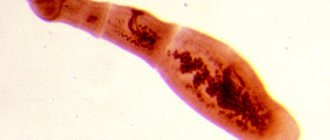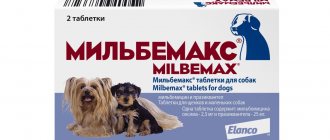Any animal, even the most well-groomed one, is not immune from infection by parasites. It is not enough for the owner to simply wash the pet and ensure that dubious “friends” do not approach him during a walk. Worms can appear in dogs at any time, and the owner needs to know how to get rid of the parasites.
Where do worms come from in dogs?
In most cases, infection with worms in dogs (helminthiasis) occurs after the pet has ingested their eggs. However, insect bites and infection through wounds on the body should not be discounted. Well, puppies that have just been born can pick up parasites through the milk of a sick mother.
Here are several factors that increase your pet's likelihood of becoming infected:
- the owner rarely washes the dog and does not devote time to his hygiene;
- preventive measures have not been carried out for a long time (quarterly deworming);
- the diet includes raw meat or fish;
- during a walk, the animal uncontrollably communicates with stray relatives, drinks from puddles, eats garbage;
- other pets in the apartment developed helminths.
Of course, these are not all possible factors, but only the most probable. Nothing can protect your pet from parasite eggs brought into the house by the owner's shoes. And although no one is immune from this scourge, owners of weakened and elderly pets, puppies and hunting breeds should be especially vigilant.
Types of worms in dogs
Experts know many varieties of worms that parasitize inside the body of pets.
Some worms in dogs live and multiply in the digestive tract, causing diseases of the internal organs and causing severe exhaustion or chronic diarrhea in the animal. Some types of helminths prefer to live in the organs of the cardiovascular system and lungs, leading to disruption of the heart, the development of pneumonia, and a painful cough. Most worms that infect the body of pets pose a real danger to human life, so it is important to know what worms look like in dogs.
There are 3 groups of parasitic worms:
- Nematodes or roundworms.
- Cestodes or tape parasites.
- Flukes , known as flatworms.
More than 80 varieties of roundworms are found in nature, but not all parasites can live in the body of a pet.
Nematodes have a round (spherical) body shape, which is why they got their name.
The most common helminthic infestations caused by roundworms are:
- Dirofilariasis . The causative agent of the disease is a white worm, the females of which reach a length of 15 cm, and the males - no more than 5 cm. Mosquitoes serve as intermediate hosts of the helminth. The larvae (microfilariae) of the parasite enter the dog’s body through the bite of a blood-sucking insect, then, through the bloodstream, rush to the main muscle - the heart. Living and actively reproducing in the organ, worms lead to disruption of its functioning. Gradually, all the cavities of the main muscle can be filled with helminths, which is why the animal always dies. Dirofilariasis is a very severe infestation, since in the early stages of the development of the disease all the signs are similar to heart failure, and an incorrect diagnosis can cost the dog his life.
- Toxocariasis . The disease is caused by 20 cm helminths with a light yellow body color. After penetrating the dog’s body, the worm larvae enter the bloodstream and spread to the vital organs of the animal (first to the liver, then to the heart and lungs).
- Ascariasis (toxascariasis). Parasitic worms have a body length of about 8 cm and are colored light yellow. Roundworms prefer to live in the intestines, gall bladder, liver and esophagus of dogs. Infection with ascariasis occurs mainly in places where dogs gather in large numbers (walking areas). Failure to treat the infestation soon leads to the death of the animal.
Cestodes are considered the largest parasitic worms. People call tapeworms tapeworms, since in appearance their body looks like a chain consisting of links.
The length of some adult worms reaches more than 10 meters. The parasite is equipped with a scolex (oral apparatus) and hooks, thanks to which it literally pierces the organs of its victim. The body of the tapeworm consists of many segments (segments). In each of the segments, the eggs of the parasite mature.
Together with feces, the segments leave the dog’s body, enter the external environment, and dry out under the influence of oxygen, leaving behind a large number of eggs.
Dogs become infected only through intermediate hosts (river fish, amphibians, blood-sucking parasites, rodents). When eating an infected animal, insect or fish, the dog swallows the parasite larva along with the food.
Once in the gastrointestinal tract, the larva is securely attached to the intestinal walls, actively feeds, grows, and after a short period of time reaches maturity.
Tapeworms in dogs are dangerous because when they accumulate massively in the intestines, they form peculiar balls, leading to complete blockage and then rupture of the organ.
Cestodes cause the following diseases:
- Diphyllobothriasis . The disease is caused by long tapeworms, their body length can be more than 10 m. Dogs become infected by eating raw fish, in which a helminth larva develops in the body.
- Dipylidia (cucumber tapeworm). The causative agent of the disease is a tape parasite with a body length of 1.5 m. Every day the worm rejects its segments containing eggs. The intermediate host of the helminth is a blood-sucking insect (in most cases fleas). A dog gets worms when it accidentally ingests a flea.
- Echinococcosis . The culprit of the disease is considered to be a tiny tapeworm, with a body length of no more than 0.5 cm. The mouthparts of the helminth are equipped with many hooks that cause severe injuries to the intestinal walls. Echinococcosis affects not only dogs, but also other animals, including farm animals.
Trematodes differ from other helminths in their small flat body, with the help of which they attach themselves to vital organs (lungs, intestines, pancreas, liver). Flukes feed on lymph, blood and mucus.
Dogs become infected by eating raw fish, frogs, and also through contact with the feces of sick animals. Trematodes cause the following diseases:
- Paragonimiasis . Flukes have an egg-shaped body, the length of which is no more than 1.3 cm. The intermediate hosts of the helminth are crustacean mollusks.
- Alariasis . The length of the parasite is no more than 4 mm, intermediate hosts are amphibians.
- Opisthorchiasis . The parasite is small in size (about 4 cm). Worm larvae can be found in raw fish or float in fresh water.
Types of helminths
There are a huge number of varieties of worms. Of course, each type results in different symptoms. However, all of them can be divided into three large groups - flatworms (cestodes), roundworms (nematodes) and flukes (trematodes). Veterinarians can accurately determine which remedy is suitable for your dog after diagnosing the type of worms.
Each type can cause serious diseases, which without proper care can worsen or even become chronic. In addition, worms in dogs can cause infection of other pets and people in the family.
Not all worms live in the intestines. Some of them choose the lungs, liver or pancreas as their home. Having settled in the organs, they begin to destroy them. That is why the disease cannot be left unattended. In rare cases, an animal may die from severe helminthiasis.
Intestinal parasites
This is the most common type of worm. The eggs enter the body through food or liquid and immediately begin to develop. Intestinal parasites mainly include tapeworms or roundworms. They can cause serious diseases such as echinococcosis, toxocariasis or hookworm.
Of course, each type of worm in dogs has specific symptoms, but there are several general signs that can be used to determine the presence of worms in the body. These include diarrhea or constipation, rapid weight loss, vomiting, lethargy, fatigue and exhaustion. Intestinal worms in dogs can clump together inside the small intestine, blocking it. If you don't provide emergency assistance to your dog, it could lead to death.
Lungworms
Often there are helminths that can spread throughout the host’s body. They move from organ to organ through soft tissues, destroying them. Having found the most favorable place for living, they settle there and begin to reproduce. One of the representatives of such parasites are roundworms. They are most often found in the lungs or stomach of animals.
If your dog experiences symptoms such as coughing, difficulty, noisy or intermittent breathing, sputum, weight loss, it is likely that he has just such “residents”. Their vital activity in the body rarely goes unnoticed. Moving inside the pet's body, they deform tissues, which often leads to internal bleeding.
The owner cannot be completely sure that a pet has lungworms. Only laboratory analysis will show an accurate result.
Heart parasites
Perhaps the most dangerous helminths are considered to be cardionematodes. Worms live mainly inside arteries, veins, in the atria of an animal, or even in the heart itself. They can enter the body through the bite of a mosquito, flea or any other blood-sucking insect. A pet may not show signs of infection for up to 6-8 months.
As soon as the incubation period ends and the parasites begin to act, the dog will experience shortness of breath, wheezing or noisy breathing, fatigue and nervousness. The animal may almost completely refuse to eat, behave lethargically, not take part in games and not even go for walks.
Under no circumstances should you delay removing worms from dogs. The doctor must prescribe a specialized medicine, which will be based on the general condition of the body. Otherwise, sudden death due to cardiac arrest or rupture is possible. Small breed dogs are at risk.
Liver parasites
As soon as the worms settle in the animal’s liver, its health and appearance deteriorate. First of all, the pet’s fur becomes dull, lethargy and an unpleasant odor from the mouth appear. The dog may not lose its appetite, but its weight is rapidly decreasing.
The abdominal area on the right increases, and ascites is often observed - accumulation of fluid in the abdominal cavity. When palpating the liver, its heterogeneity is felt, and the dog becomes restless and may even whine in pain.
Subcutaneous worms
This is a fairly rare occurrence, but it can still occur in any dog. The insidiousness of infection with subcutaneous worms in dogs is asymptomatic, which can last several months. As soon as the disease shows itself, the dog develops:
- swelling of the muzzle;
- scratching that occurs due to knotty blisters on the skin;
- strong thirst;
- lethargy, drowsiness;
- darkening of urine.
For all of the listed symptoms of subcutaneous worms in dogs, you must contact a veterinary clinic, since independent treatment in this case is impossible.
The danger of worms in dogs
Worms under a microscope
Know that helminthiasis is a disease of the entire body of an animal, accompanied by severe clinical symptoms.
First of all, intestinal parasites cause pathology of the gastrointestinal tract.
A massive accumulation of nematodes or cestodes in the lumen of the dog’s digestive tract causes blockage, followed by rupture of the intestinal wall, hemorrhage and peritonitis.
During their life, helminths secrete metabolic products (metabolites) that are toxic to the body, as a result of which pathological phenomena develop in organs and tissues.
Worms, as irritants, penetrate into organs and tissues, resulting in an allergic reaction. In addition, parasites introduce pathogenic microbes from the external environment, activate the “dormant” microflora in the body, reducing the body’s resistance, and contribute to the occurrence of infectious diseases.
Some types of worms in dogs are dangerous to humans. After all, if proper hygiene is not observed, some helminths are transmitted from animals to humans. An example of this is roundworms. Therefore, a couple of times a year it is worth carrying out preventive deworming of your pet, thereby protecting yourself from the risk of infection.
Causes and sources of infection
Life cycle of worms
An animal can become infected with worms throughout the year, especially in warm weather. Eggs and larvae of helminths are everywhere on the street: in the soil, in the water, etc. Eggs that fall into the soil with the feces of other animals quickly turn into larvae.
For this process, a temperature of at least 12-13 degrees Celsius is sufficient. Also, parasite eggs can safely overwinter even at sub-zero temperatures, and begin to develop in the spring. There is no way to be sure that your dog will not pick up the parasite when picking up his favorite toy from the ground during a walk.
A dog can also become infected with worms in the womb. The larvae enter the bloodstream and through the placenta infect the organisms of unborn puppies. Also, larvae can enter the puppy’s body when feeding with mother’s milk.
Another source of infection is fleas. If fleas are present, veterinarians will prescribe deworming. Because fleas carry flatworms. While licking and combing itself, the animal often swallows dangerous parasites.
Where do worms come from?
Types of helminths
Helminths are divided into 3 types: nematodes (roundworms), trematodes (digenetic flukes) and cestodes (tapeworms, tapeworms).
Nematode worms
Nematodes are roundworms (cross section) and there are estimated to be about a million species. Fortunately, not all of them are parasites, and some are adapted to live in the bodies of animals. Common infections are: Toxocara, Toxascaris, Ancylostoma, Dirofilaria.
Trematodes are flatworms, flukes (7,200 species have been described) and have two suckers on their body, which are securely attached to the tissues of the host. They have great fertility. Trematodes common among dogs. Names of invasions: Opisthorchiasis, Alaria, Paragonimosis
Cestodes are tapeworms (3,500 species have been described), with a flat body shape that consists of several segments (hence the “popular” name - tapeworms), the diseases they cause are called cestodosis. Some reach a length of more than 10 meters. The following types of cestodiasis are common among dogs: Dipylidium caninum, Echinococcosis (Echinococcus granulosus), Diphyllobothrium latum.
Why are helminths dangerous?
At first glance, it seems that the infection does not have serious consequences. But this assumption is misleading. If help was not provided on time, the disease will lead to serious consequences.
For dogs
In four-legged animals, helminthiasis can provoke:
- retardation in mental and physical development in puppies;
- weakened immunity, increased likelihood of viral diseases;
- accession of infections;
- intoxication of the body with waste products of worms, allergies, loss of consciousness.
Often neglected parasitosis leads to various pathologies of internal organs: liver, lungs, heart and gastrointestinal tract. In addition, the likelihood of developing or worsening allergies, jaundice, vision loss, stroke, epilepsy and many other diseases increases. The owner's negligence can lead to death.
It is not always possible to recognize whether a dog is infected or not. According to statistics, more than 60% of all pets have helminths, but behave and look completely normal - all due to the fact that the symptoms of worms in dogs do not always manifest themselves clearly. The owners get the impression that the animal is healthy, although in fact it needs help.
For man
It often happens that dog worms appear in humans. This happens when there is close contact between people and animals, as well as when hygiene rules are not followed. Ideally, if an animal is diagnosed with helminths, treatment should be carried out not only on all pets in the house, but also on people. All family members need to get tested and get advice from a doctor.
Symptoms of infection
In the early stages, it is almost impossible to identify worms in dogs. Symptoms only appear when the worms begin to multiply and cause harm to the host organism. At this time, the owner may notice eggs in the animal’s feces, similar to small grains of rice, or the parasites themselves. This indicates severe infection.
In addition to the presence of parasites in feces, helminthiasis can be detected by the following signs:
- diarrhea, vomiting;
- refusal to eat;
- skin rash;
- rapid weight loss, visual malaise;
- heavy breathing, cough;
- Puppies may have excessive bloating;
- dullness, brittleness of wool;
- The dog constantly rubs his tail on the floor, which indicates itching in the anus.
If you notice any of these signs in your pet, contact a professional immediately. The symptoms of helminthiasis may be similar to the symptoms of other diseases, and only a doctor can adequately assess the pet’s condition in order to prescribe treatment.
Symptoms of worms in dogs
Any owner of a four-legged friend should know the signs of a helminthic infestation that has developed in a pet. Symptoms of worms in dogs are as follows:
- Dramatic weight loss. Parasitic worms suck out all the beneficial substances from the dog, as a result of which the animal’s body becomes exhausted.
- Frequent rumbling in the stomach, an increase in the volume of the abdominal cavity. Worms in dogs, such as roundworms, cause similar symptoms.
- Frequent vomiting. Occurs mainly when dogs are infected with tapeworms.
- Prolonged diarrhea. Indicates infection with whipworms or nematodes.
- Blood and mucus in feces. Happens when dogs are affected by hookworm.
- Skin rash, dullness and hair loss. It is considered a characteristic sign of roundworms.
- The presence in the animal's feces of white moving segments, similar to rice or cucumber grains. In this case, determining that a dog has worms (cestodes) is not difficult.
- Painful sensations and itching in the perineum. The animal constantly tries to ride on its butt and lick the anus. This behavior indicates characteristic signs of worms in a dog.
- Paleness of the mucous membranes of the eyes and mouth. The dog's loss of nutrients leads to the development of anemia.
In dogs of small breeds, helminthic infestations are more severe than in large dogs. Most decorative pets do not tolerate anthelmintic drugs well, so pets should be treated only under the strict supervision of a veterinarian.
Parasites living in the heart are quite difficult to identify. You can know that your dog has worms if you experience symptoms such as:
- increased breathing, attacks of shortness of breath;
- abdominal enlargement;
- painful cough;
- severe weakness of the body;
- sudden hair loss.
Heartworm is dangerous because all the symptoms of its presence appear only when the disease has become widespread and it is no longer possible to save the dog.
How to diagnose helminths
How to determine if a dog has worms? Contact a veterinary clinic. Blood and stool tests must be taken so that specialists can check for the presence of parasite eggs or adult parasites. The tests are good because they allow you to determine not only the presence of worms in an animal, but also their type, which means it makes it possible to prescribe treatment as accurately as possible.
Inexperienced owners often refuse a blood test, citing the fact that just a stool test is enough. Thus, they do not make it possible to detect those parasites that live outside the intestines, that is, inside other organs or blood vessels. Enzyme immunoassay and polymerase chain reaction are considered the most accurate and informative.
If your doctor suspects a pulmonary or cardiac infection, he will likely order an ultrasound or x-ray.
Even if you find eggs in your dog’s stool yourself, be sure to get all tests done. If an animal is infected with at least one type of parasite, then there is a possibility that other worms also live in the body.
The first signs of worms in a dog
All helminthiases are divided according to the type of worms that cause them. The main parasites are flat tapeworms (cestodes), roundworms (nematodes) or flukes (trematodes). Each type causes certain diseases, which can result in a chronic course with complete depletion of the body. Infection with worms is dangerous because nematodes and whipworms are easily transmitted to humans.
The first symptoms in dogs with worms, in which one can suspect the animal’s illness:
- in feces, on fur, near the anus you can find individual segments, fragments or whole worms;
- the dog tends to scratch the anus on the ground or surrounding objects;
- the pet’s general condition worsens, its appetite increases or decreases, its hair falls out, lethargy appears, the mucous membranes become pale (here it is important to separate infection from hypovitaminosis);
- unstable stool (alternating constipation and diarrhea).
Helminthiases, depending on the intensity of invasion and the reactivity of the body, can be asymptomatic or with pronounced symptoms of mild or severe form. Because of this, if your dog’s health worsens, you should contact a veterinarian. Analyzes of organs, tissues, blood and feces will help to promptly identify the disease and prescribe treatment.
How to treat helminthiasis
Therapy is aimed primarily at the complete destruction of eggs and adults. As soon as the parasites stop causing harm to the body, all unpleasant symptoms disappear, and the process of restoration of the body begins. The medications prescribed by the veterinarian depend on the type of worms and the severity of the disease. In most cases, it is allowed to treat the animal yourself with the medications prescribed by the veterinarian, but sometimes the situation may require immediate surgical intervention.
Drug therapy
The simplest and most common form of medicine for worms is a tablet. A wide variety of them can be found both in regular and veterinary pharmacies. Medicines are also common in the form of drops for external use and suspensions for oral use. The drops are characterized by the fact that they destroy not only internal parasites, but also fleas, ticks and other blood-sucking insects.
In addition to drugs against worms, the doctor may prescribe medications that prevent the remains of dead parasites from blocking blood vessels. Often, along with treatment, the veterinarian prescribes a variety of vitamin complexes and means to restore immunity. If the symptoms of infection include fever or other signs that require immediate intervention, medications will be prescribed to relieve or alleviate them (antipyretic, detoxifying). The dosage and treatment period are selected individually for each animal.
Surgical intervention
In particularly severe cases, surgery may be required to treat helminthiasis. The dog is operated under anesthesia, removing a section of infected tissue along with the parasites.
Before the operation, it is necessary to carry out a complete diagnosis of the animal and a course of medication. After the operation is completed, the veterinarian will prescribe individual treatment to strengthen the immune system, provide general support to the body, and prevent complications.
Sometimes parasites are removed using endoscopic intervention - the safe removal of worms from the heart and atria. Endoscopy requires no incisions and has the lowest risk of complications.
Treatment rules
There are several general rules that will help you cure your pet of parasites easily and without consequences.
First you need to undergo an examination by a veterinarian. Only he will be able to prescribe an effective treatment method and recommend medications to you. If your doctor has given you permission to treat yourself at home and you have already bought the pills, be sure to read the instructions. Pay special attention to dosage, indications for use and side effects.
The medicine is usually given in the morning, half an hour before the first meal. In some cases, it is necessary to give the anthelmintic at other times - this will be indicated in the instructions. A few days before taking medications, treat your pet for fleas, ticks and other insects.
Once you have started treatment, it is important to provide your dog with constant access to clean and fresh water. He will drink a lot while on medication. If within several hours after taking the drug the dog still does not go to the toilet, you should give him a laxative.
After 10-14 days it is necessary to re-treat. During this time, carefully monitor your pet. If there were a lot of parasites, an excessive amount of their remains can lead to intoxication of the body: this will manifest itself in vomiting, convulsions and loss of consciousness. If these symptoms occur, you should take the animal to the veterinarian.
Prevention of worms in dogs
It is impossible to completely protect your pet from parasites. But this does not mean that the risk of infection cannot be reduced.
Be sure to regularly carry out preventive deworming. Give your dog an anti-worm tablet every 3 months. And even if there are no symptoms, have your dog’s stool and blood tested at least once a year.
Do not feed your pet raw meat and fish. Boil them or scald them with boiling water. Of course, under no circumstances allow your dog to drink from puddles, rivers, lakes, or eat anything on the street.
Remove fleas and get rid of ticks in a timely manner, use special products and shampoos. Make sure your dog does not interact with stray animals.
If you follow simple prevention rules, you won't have to worry about your pet getting infected. And if this happens, immediately contact a specialist.
The article is for informational purposes only. Contact your veterinarian!
Treatment of worms in dogs
If you notice even one sign from the full list in your pet, know: your pet is most likely infected with worms. Don’t hesitate, contact your veterinarian, describe the problem and symptoms to them, and also ask them to prescribe the necessary treatment for your dog. If at the moment you are unable to bring your animal to the clinic, visit a special veterinary pharmacy and ask what anthelmintic drug they can recommend for you. When choosing a medicine, pay attention to its composition, dosage and frequency of administration - this is important!
Remember that you cannot give your dog “human” anthelmintics! Special medications have been developed for animals (both in the form of tablets and in liquid form - suspensions for worms in dogs). The tablets are placed in food, and the suspension is immediately poured into the mouth.
In case of severe infection, even 10 days after taking the drug, symptoms may remain. In this case, it is necessary to repeat the course of treatment or change the drug to another one of the same effect.
In practice, the most effective treatment can be selected by a veterinarian after taking tests from the animal (he will recommend a drug that fights exactly those parasites found on your four-legged friend, in the right dosage) - so you should not treat your dog yourself. This way you can avoid mistakes in treating the poor animal. Have you noticed worms in your dog? The veterinarian will tell you what to treat (drugs and dosage).
To consult a veterinarian in Volzhsky, call 8-927-523-07-46
Prevention of worms in dogs
It is common for any responsible pet owner to take care of the health of their four-legged friend. In order not to think about how to remove worms from a dog, it is worth carrying out timely prevention of possible health problems:
- be sure to monitor your dog’s diet (exclude raw meat, river fish, as well as unwashed fruits and vegetables from its diet);
- on walks, do not let your pet act as a “scavenger” or drink water from dirty ponds and puddles;
- limit close contacts of the animal with other animals (this way you will avoid not only worms, but also fleas and ticks);
- Once every 3 months, give your dog prophylactic doses of anthelmintic drugs (make sure that there are no other animals infected with worms in the house or apartment).










